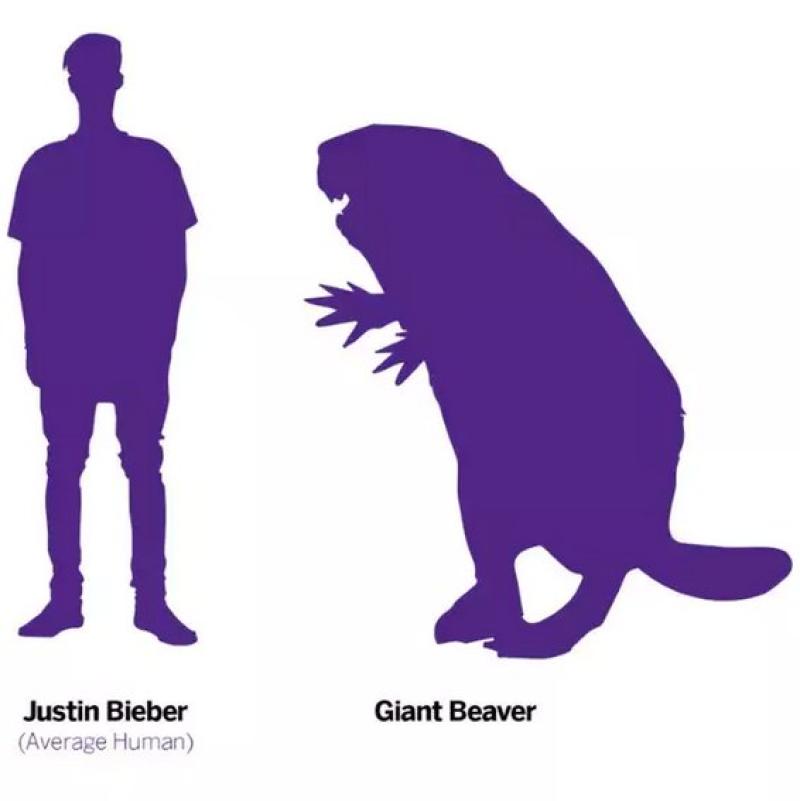Why giant human-sized beavers died out 10,000 years ago




Now extinc t, the giant beaver was once a highly successful species. Scientists have found its fossil remains at sites from Florida to Alaska and the Yukon .
A super-sized version of the modern beaver in appearance, the giant beaver tipped the scales at 100 kilograms. But it had two crucial differences.
The giant beaver lacked the iconic paddle-shaped tail we see on today’s modern beavers. Instead it had a long skinny tail like a muskrat.
The teeth also looked different. Modern beaver incisors (front teeth) are sharp and chisel-like; giant beaver incisors were bulkier and curved, and lacked a sharp cutting edge.

A side-by-side comparison of the modern beaver, Justin Bieber and the giant beaver, all part of Canada’s history.
Illustration by Scott Woods/Western University
You are what you eat
We need to understand how the giant beaver lived in order to explain how and why it died out. For example, did it run out of food? Did it get too cold or too hot for it to survive?
Other studies found the giant beaver thrived when the climate was warmer and wetter . They also noticed that giant beaver fossils were most commonly found in sediments that come from ancient wetlands . But no one knew if the giant beaver behaved like the modern beaver. Did it also cut down trees? Or did it eat something completely different?
From an chemical perspective, you are what you eat! The food an animal consumes contains chemical signatures called stable isotopes that are incorporated into body tissues such as bone.
These isotopic signatures remain stable over time, for tens of thousands of years, and provide a window into the past. No other studies have used stable isotopes to figure out the giant beaver’s diet.

Giant beaver skull.
Florida Museum of Natural History
The isotopic signatures linked to woody plants are different from those associated with aquatic plants. We discovered that the giant beaver was not cutting down and eating trees. Instead, it was eating aquatic plants .
This strongly suggests that the giant beaver was not an “ecosystem engineer” like the modern beaver. It was not cutting down trees for food or building giant lodges and dams across the ice age landscape.
Instead, this diet of aquatic plants made the giant beaver highly dependent on wetland habitat for both food and shelter from predators. It also made it vulnerable to climate change.
Warm and dry climate
Towards the end of the last ice age 10,000 years ago, the climate became increasingly warm and dry and wetland habitats began to dry up. Although the modern beavers and the giant beaver co-existed on the landscape for tens of thousands of years , only one species survived.

A giant beaver skeleton.
Tessa Plint
This all fits into the puzzle that many research groups have been working on for decades: we all want to know what caused the global megafauna extinction event that occurred at the end of the last ice age and why so many species of large-bodied animals — woolly mammoths, mastodons and giant ground sloths — disappeared at roughly the same time.
Current evidence indicates that a combination of climate change and human impact were the driving causes behind these extinctions .
Studying the ecological vulnerabilities of long-extinct animals certainly poses its own unique challenges, but it is important to understand the impact of climate change on all species, past or present.
Initial image: The now-extinct giant beaver once lived from Florida to Alaska. It weighed as much as 100 kilograms, roughly the same as a small black bear. Illustrated by Luke Dickey/Western University , Author provided



Global warming brought the last large Ice Age to an end. And it's been warming ever since.
Rising temperatures in addition to human predation caused many ancient species to become extinct.
I guess I am dumb on how these things work.
I would think if it was eating plants, it would need molar like teeth to chew it up.
Unless it's digestive system was adapted to digest "bulk" material of food intake. Aquatic plants might have been easier for the beaver to swallow and/or process. But its size may also have been a contributing factor in its extinction: a large size means it requires a much higher nutrient intake to maintain body systems. Any disruption in its habitat can mean a loss in adequate intake and eventual starvation. But that's just speculation on my part.
True. I was just going by what we have now, like the manatee. They have molars. But they are called sea cows for a reason. Haha
Interesting article, thanks.
Hmmm?
Mega fauna and some humans vanished in that same time period. Anyone remember Clovis People?
Anyone also remember the Black Mat, below which the mega fauna and Clovis People existed and above which there are no signs?
Geology Professor Nick Zentner of Central Washington University once stated in a lecture that most earth scientists are stove pipe in their findings, thinking's, observations, etc.
He is right and is one who looks outside of the box to notice convergences of "things happening".
The Black Mat tells us some massive catastrophe occurred in North America in that time frame. then, of course all life was put at risk as far as South America.
One can't help but think back to the major dino extinction event when only the smaller land creatures survived and similar survival occurred after the Black Mat event in North America.
Definitely of the opinion a single targeted event aimed at the giant beaver was a culprit.
WAS NOT A CULPRIT
When it comes to beavers, I am a fan.